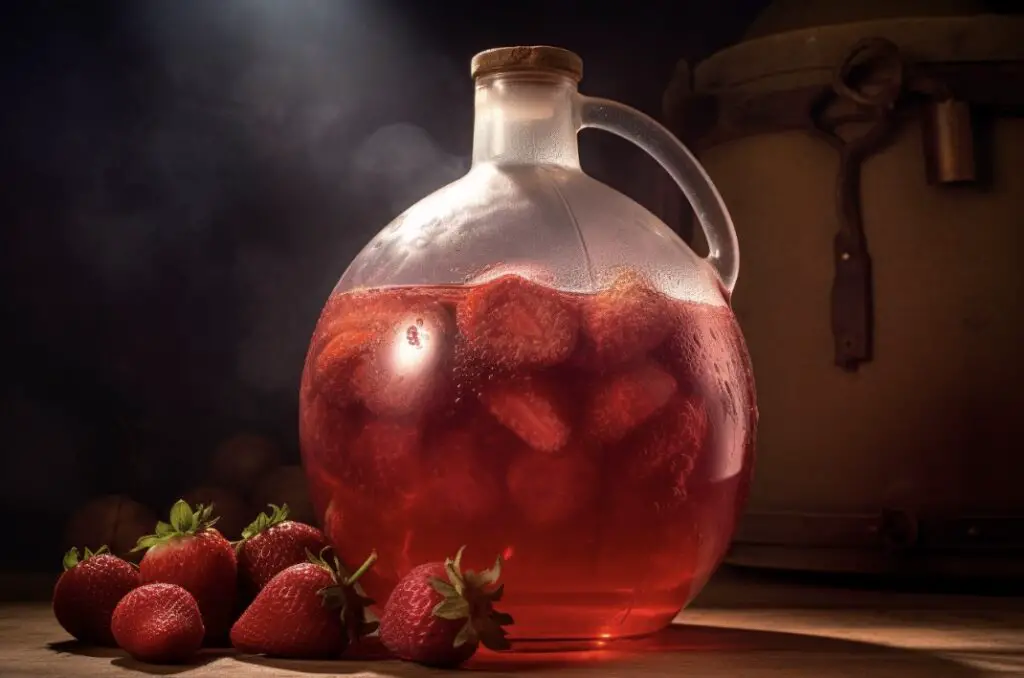Fermentation is an age-old process that has been used to preserve and enhance the flavors of various food and drinks.
From kimchi to kombucha, yogurt to beer, the process of fermentation has been an essential part of human culinary history. One question that often arises among homebrewers and fermentation enthusiasts is: can you ferment strawberries?
Yes, you can ferment strawberries. The process of fermenting strawberries is not only possible but also offers a unique and delightful twist on this beloved fruit, resulting in a delicious and healthy treat or beverage.
In this blog post, we will explore the answer to this question and delve into the fascinating world of strawberry fermentation.
1. The Science Behind Strawberry Fermentation
To understand how strawberries can be fermented, it’s essential to have a basic understanding of the science behind fermentation.

Fermentation is a natural process where microorganisms, such as yeast and bacteria, convert sugars and other organic compounds into acids, gases, or alcohol.
This process not only helps preserve the food but also enhances its flavors and nutritional content.
As an experienced brewer, I have spent years experimenting with different ingredients and fermentation techniques. I have found that understanding the science behind fermentation is key to mastering the art of creating delicious and unique fermented foods and beverages.
2. Preparing Strawberries for Fermentation
Before you can ferment strawberries, you must first prepare them properly. This involves cleaning the strawberries thoroughly, removing any dirt, debris, or pesticides that may be present.
You will also need to remove the green tops and any bruised or damaged areas, as these can negatively affect the fermentation process.

When I first began experimenting with strawberry fermentation, I quickly learned the importance of proper preparation.
Over time, I have developed a method that works well for me: I gently rinse the strawberries under cold running water, then use a soft brush to clean them. I then carefully remove the green tops and any damaged areas.
3. Choosing the Right Fermentation Method
There are several methods for fermenting strawberries, each with its own unique characteristics and resulting flavors. Some of the most popular methods include:
- Lacto-fermentation
- Alcohol fermentation
- Vinegar fermentation
Certainly! Here are more detailed explanations of the three suggested options for fermenting strawberries:
- Lacto-fermentation:
Lacto-fermentation is a process that involves the use of lactic acid bacteria to convert sugars in the strawberries into lactic acid. This method creates a tangy and slightly sour flavor profile while preserving the natural sweetness of the fruit.
To lacto-ferment strawberries, they are typically combined with a brine solution consisting of water, salt, and sometimes additional flavorings like herbs or spices.
The strawberries are submerged in the brine and left to ferment at room temperature for a certain period, usually a few days to a week. Lacto-fermented strawberries can be enjoyed as a condiment, added to salads, or used in various culinary creations. - Alcohol fermentation:
Alcohol fermentation involves the conversion of sugars in the strawberries into ethanol (alcohol) and carbon dioxide by yeast or other microorganisms. This process is commonly used in winemaking and brewing. To ferment strawberries into alcohol, the fruit is crushed or pureed to extract the juice. Yeast is then added to the juice, initiating fermentation.
It is crucial to select the right type of yeast when fermenting strawberries – and I have made a guide for that here!
The yeast consumes the sugars and produces alcohol as a byproduct. The fermentation process typically takes a few weeks to several months, depending on the desired alcoholic beverage being produced. The resulting strawberry alcohol can be enjoyed as a homemade wine, strawberry liqueur, or even used as a base for cocktails. - Vinegar fermentation:
Vinegar fermentation involves the conversion of ethanol (alcohol) into acetic acid by acetic acid bacteria. This process turns alcoholic liquids, such as fermented strawberry wine or a strawberry-infused solution, into vinegar. The acetic acid bacteria, commonly known as vinegar mother, are added to the liquid and left to ferment for several weeks to months.
During this time, the bacteria consume the ethanol and convert it into acetic acid, giving the liquid its distinctive tart and acidic taste. The resulting strawberry vinegar can be used in salad dressings, marinades, pickling solutions, or as a flavor enhancer in various dishes.
These three methods provide different flavor profiles and uses for fermented strawberries, allowing for a variety of culinary applications and experimentation with taste.
I have tried all three of these methods, and they each produce delicious results. Lacto-fermentation results in a tangy, probiotic-rich treat, while alcohol fermentation creates a fruity, boozy beverage. Vinegar fermentation, on the other hand, yields a versatile strawberry vinegar perfect for use in salad dressings and marinades.
4. Creating the Perfect Fermentation Environment
Successful fermentation relies on creating the ideal environment for the specific microorganisms you are working with.
This typically involves controlling factors such as temperature, pH, and salinity. For example, lacto-fermentation requires a slightly acidic environment, while alcohol fermentation thrives in a more neutral pH.
Through trial and error, I have learned the importance of carefully monitoring and adjusting the fermentation environment. This can be as simple as using an airlock to keep oxygen out of the fermenting vessel or as complex as maintaining a specific temperature range to encourage the growth of desired microorganisms.
5. Monitoring the Fermentation Process
Fermenting strawberries can take anywhere from a few days to several weeks, depending on the method and desired flavor profile. It is crucial to keep an eye on the fermentation process, checking for signs of spoilage or undesirable bacterial growth.

Over the years, I have found that patience and attention to detail are key when it comes to monitoring the fermentation process. I regularly check on my fermenting strawberries, tasting them to assess their flavor development and ensure that the fermentation is proceeding as desired.
6. Storing and Using Fermented Strawberries
Once the fermentation process is complete, it is essential to properly store the fermented strawberries to ensure they remain fresh and delicious. This may involve refrigeration, canning, or other preservation methods, depending on the type of fermentation and intended use.
I have found that fermented strawberries are incredibly versatile and can be used in a variety of dishes and beverages. From adding a tangy twist to smoothies and yogurt to incorporating them into cocktails and desserts, the possibilities are endless.
7. Health Benefits of Fermented Strawberries
In addition to their unique flavor, fermented strawberries also offer numerous health benefits. These may include:
- Improved digestion
- Enhanced nutrient absorption
- Increased levels of beneficial probiotics
- Antioxidant properties
As a regular consumer of fermented foods and beverages, I have experienced firsthand the positive impact they can have on overall health and well-being. Incorporating fermented strawberries into my diet has not only added a delicious new flavor to my meals but has also contributed to improved gut health and overall wellness.
8. Troubleshooting Common Fermentation Issues
As with any fermentation process, there can be potential issues that arise when fermenting strawberries. Some common problems include:
- Mold growth
- Off-flavors or smells
- Slow or stalled fermentation
Through my years of fermentation experience, I have encountered and overcome various issues. I have learned that the key to successful fermentation is understanding the underlying causes of these problems and implementing the appropriate solutions.
9. Experimenting with Fermented Strawberry Recipes
Fermented strawberries can be used in a wide array of recipes, from beverages to desserts. Don’t be afraid to get creative and experiment with different flavor combinations and techniques to find your perfect fermented strawberry creation.
One of the joys of being a home brewer and fermentation enthusiast is the endless opportunity for experimentation and discovery. I have enjoyed trying various fermented strawberry recipes and have even developed some of my own signature creations.
In Conclusion: Can You Ferment Strawberries?
Yes, you can ferment strawberries! Fermented strawberries offer a unique and delicious twist on this beloved fruit, providing a versatile and healthy addition to your culinary repertoire. Here are 10 facts to remember about fermenting strawberries:
1. Strawberries can be fermented using various methods, including lacto-fermentation, alcohol fermentation, and vinegar fermentation.
2. Proper preparation of the strawberries is essential for successful fermentation.
3. Creating the ideal fermentation environment is crucial for encouraging the growth of beneficial microorganisms.
4. Monitoring the fermentation process helps ensure the desired flavor and prevents spoilage.
5. Fermentation times can vary from a few days to several weeks, depending on the method and desired flavor profile.
6. Proper storage and preservation of fermented strawberries are essential for maintaining their quality and freshness.
7. Fermented strawberries offer numerous potential health benefits, including improved digestion and increased levels of beneficial probiotics.
8. Troubleshooting common fermentation issues is an essential skill for any fermentation enthusiast.
9. Fermented strawberries can be used in a wide variety of recipes, from beverages to desserts.
10. Experimentation and creativity are key to discovering your perfect fermented strawberry creation.
FAQs
How long does it take fruit to turn into alcohol?
The length of time it takes for fruit to turn into alcohol depends on various factors such as the type of fruit, the amount of sugar present, and the yeast used. Generally, it can take anywhere from a few days to several weeks for fruit to ferment and turn into alcohol.
Can you ferment fruit into alcohol?
Yes, fruit can be fermented into alcohol through the process of natural fermentation or by adding yeast to the fruit mixture. The sugar in the fruit is converted into alcohol and carbon dioxide by the yeast during the fermentation process.
How long does it take pineapple to turn into alcohol?
Pineapple can turn into alcohol within a few days to a few weeks depending on the method of fermentation used.
Are fermented strawberries alcoholic?
Fermented strawberries can contain small amounts of alcohol, but the alcohol content is typically very low and not enough to cause intoxication.
Can I make alcohol from pineapples?
Yes, it is possible to make alcohol from pineapples by fermenting the fruit juice with yeast. The resulting product is called pineapple wine or pineapple beer, depending on the alcohol content and brewing process.
Can strawberries become alcohol?
Yes, strawberries can be fermented to produce alcohol. The sugar in the strawberries is converted into alcohol by yeast during the fermentation process. However, the alcohol content will depend on the amount of sugar in the strawberries and the length of fermentation.




